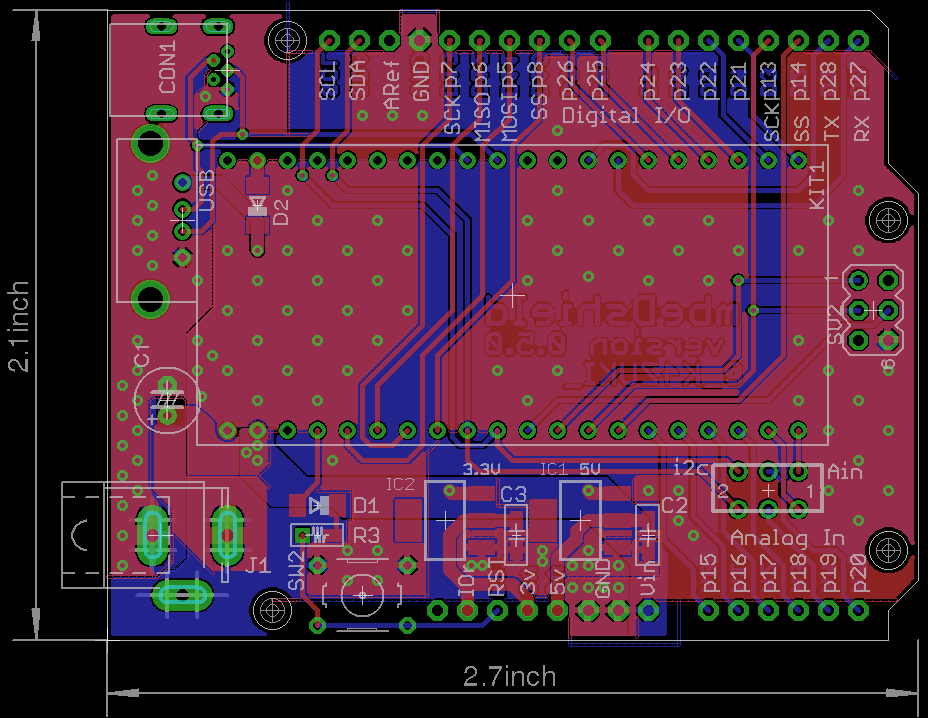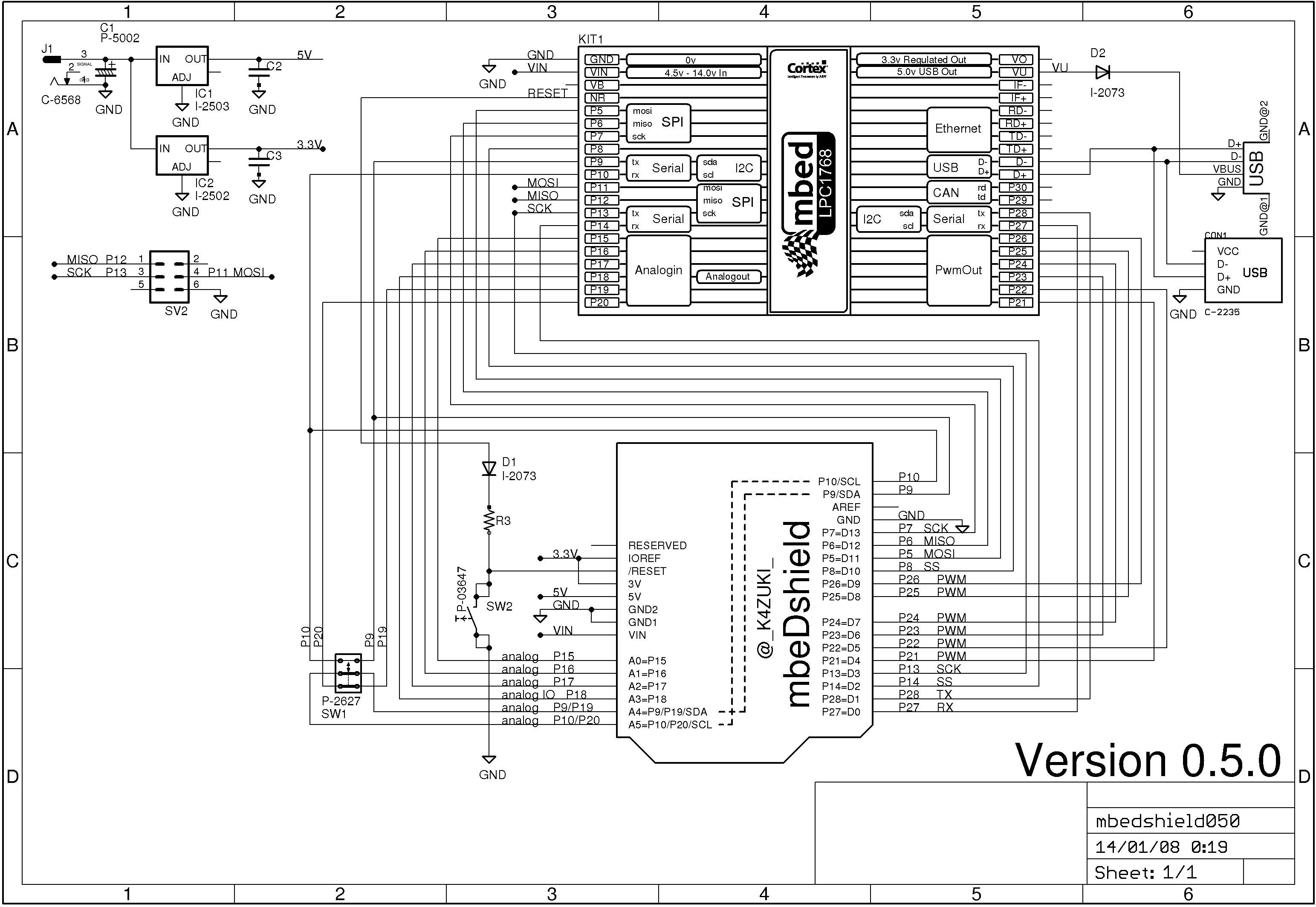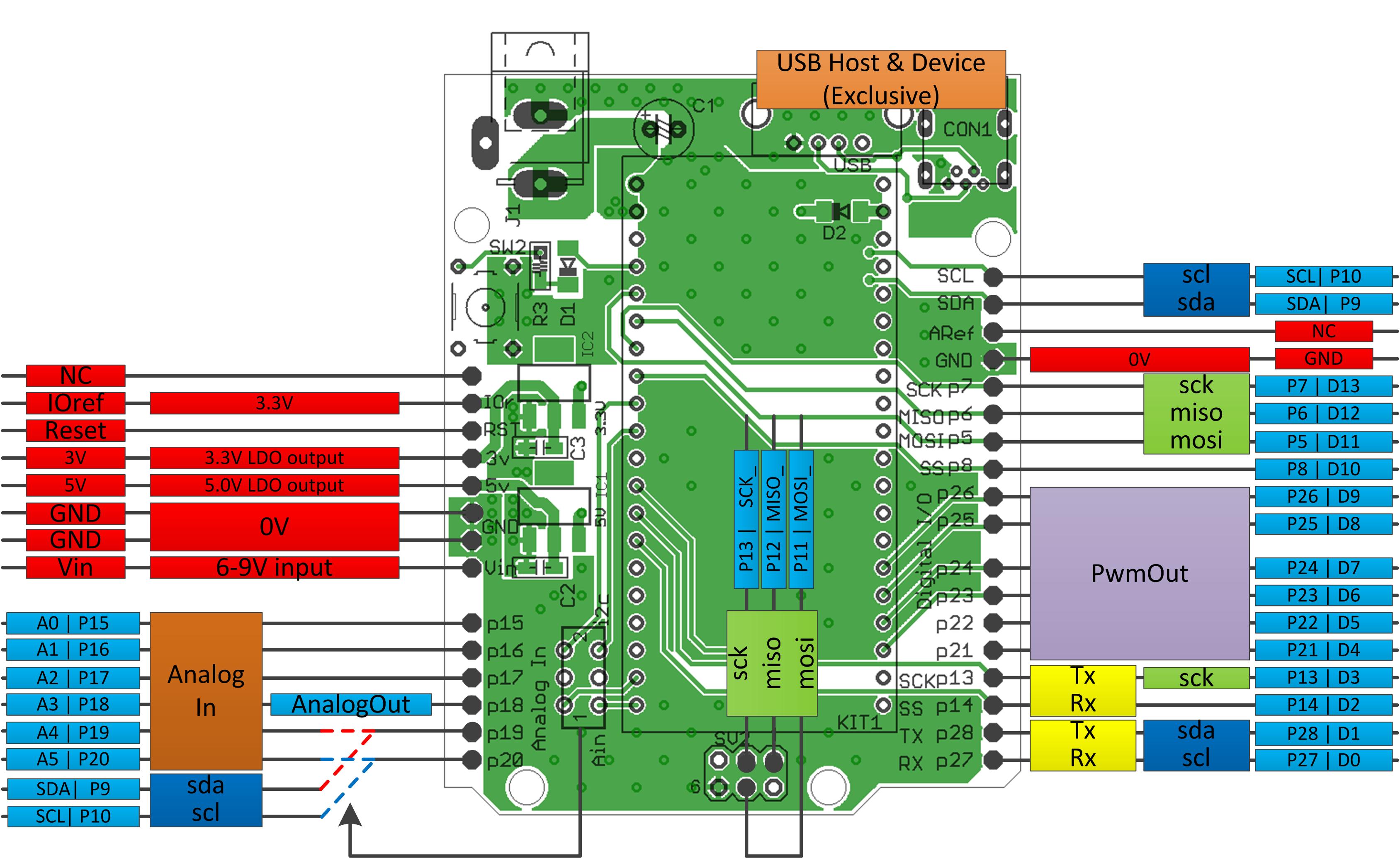The official mbed C/C SDK provides the software platform and libraries to build your applications.
Fork of mbed by
(01.May.2014) started sales! http://www.switch-science.com/catalog/1717/
(13.March.2014) updated to 0.5.0
This is a pin conversion PCB from mbed 1768/11U24 to arduino UNO.
- So if you have both mbed and arduino shields, I guess you would be happy with such a conversion board :)
Photos
- Board photo vvv

- Schematic photo vvv

- Functionality photo vvv

Latest eagle files
PCB >> /media/uploads/k4zuki/mbedshield050.brd
SCH >> /media/uploads/k4zuki/mbedshield050.sch
BIG changes from previous version
- Ethernet RJ45 connector is removed.
- http://mbed.org/components/Seeed-Ethernet-Shield-V20/ is the biggest hint to use Ethernet!
MostALL of components can be bought at Akizuki http://akizukidenshi.com/- But sorry, they do not send parts to abroad
- Pinout is changed!
| arduino | 0.4.0 | 0.5.0 |
|---|---|---|
| D4 | p12 | p21 |
| D5 | p11 | p22 |
| MOSI_ | none | p11 |
| MISO_ | none | p12 |
| SCK_ | none | p13 |
This design has bug(s)
- I2C functional pin differs between 1768 and 11U24.
Fixed bugs here
- MiniUSB cable cannot be connected on mbed if you solder high-height electrolytic capacitor on C3.
- http://akizukidenshi.com/catalog/g/gP-05002/ is the solution to make this 100% AKIZUKI parts!
- the 6-pin ISP port is not inprimented in version 0.4.0
it will be fixed in later version 0.4.1/0.4.2/0.5.0This has beenfixed
I am doing some porting to use existing arduino shields but it may faster if you do it by yourself...
you can use arduino PinName "A0-A5,D0-D13" plus backside SPI port for easier porting.
To do this you have to edit PinName enum in
- "mbed/TARGET_LPC1768/PinNames.h" or
- "mbed/TARGET_LPC11U24/PinNames.h" as per your target mbed.
here is the actual list: This list includes define switch to switch pin assignment
part_of_PinNames.h
USBTX = P0_2,
USBRX = P0_3,
//from here mbeDshield mod
D0=p27,
D1=p28,
D2=p14,
D3=p13,
#ifdef MBEDSHIELD_050
MOSI_=p11,
MISO_=p12,
SCK_=p13,
D4=p21,
D5=p22,
#else
D4=p12,
D5=p11,
#endif
D6=p23,
D7=p24,
D8=p25,
D9=p26,
D10=p8,
D11=p5,
D12=p6,
D13=p7,
A0=p15,
A1=p16,
A2=p17,
A3=p18,
A4=p19,
A5=p20,
SDA=p9,
SCL=p10,
//mbeDshield mod ends here
// Not connected
NC = (int)0xFFFFFFFF
Diff: LPC1768/GCC_ARM/LPC1768.ld
- Revision:
- 41:10b9abbe79a6
- Child:
- 44:24d45a770a51
diff -r 976df7c37ad5 -r 10b9abbe79a6 LPC1768/GCC_ARM/LPC1768.ld
--- /dev/null Thu Jan 01 00:00:00 1970 +0000
+++ b/LPC1768/GCC_ARM/LPC1768.ld Thu Jul 12 10:10:08 2012 +0100
@@ -0,0 +1,150 @@
+/* Linker script for mbed LPC1768 */
+GROUP(-lstdc++ -lsupc++ -lm -lc -lnosys -lgcc)
+
+/* Linker script to configure memory regions. */
+MEMORY
+{
+ FLASH (rx) : ORIGIN = 0x00000000, LENGTH = 512K
+ RAM (rwx) : ORIGIN = 0x100000C8, LENGTH = 0x7F38
+
+ USB_RAM(rwx) : ORIGIN = 0x2007C000, LENGTH = 16K
+ ETH_RAM(rwx) : ORIGIN = 0x20080000, LENGTH = 16K
+}
+
+/* Linker script to place sections and symbol values. Should be used together
+ * with other linker script that defines memory regions FLASH and RAM.
+ * It references following symbols, which must be defined in code:
+ * Reset_Handler : Entry of reset handler
+ *
+ * It defines following symbols, which code can use without definition:
+ * __exidx_start
+ * __exidx_end
+ * __etext
+ * __data_start__
+ * __preinit_array_start
+ * __preinit_array_end
+ * __init_array_start
+ * __init_array_end
+ * __fini_array_start
+ * __fini_array_end
+ * __data_end__
+ * __bss_start__
+ * __bss_end__
+ * __end__
+ * end
+ * __HeapLimit
+ * __StackLimit
+ * __StackTop
+ * __stack
+ */
+ENTRY(Reset_Handler)
+
+SECTIONS
+{
+ .text :
+ {
+ KEEP(*(.isr_vector))
+ *(.text*)
+
+ KEEP(*(.init))
+ KEEP(*(.fini))
+
+ /* .ctors */
+ *crtbegin.o(.ctors)
+ *crtbegin?.o(.ctors)
+ *(EXCLUDE_FILE(*crtend?.o *crtend.o) .ctors)
+ *(SORT(.ctors.*))
+ *(.ctors)
+
+ /* .dtors */
+ *crtbegin.o(.dtors)
+ *crtbegin?.o(.dtors)
+ *(EXCLUDE_FILE(*crtend?.o *crtend.o) .dtors)
+ *(SORT(.dtors.*))
+ *(.dtors)
+
+ *(.rodata*)
+
+ KEEP(*(.eh_frame*))
+ } > FLASH
+
+ .ARM.extab :
+ {
+ *(.ARM.extab* .gnu.linkonce.armextab.*)
+ } > FLASH
+
+ __exidx_start = .;
+ .ARM.exidx :
+ {
+ *(.ARM.exidx* .gnu.linkonce.armexidx.*)
+ } > FLASH
+ __exidx_end = .;
+
+ __etext = .;
+
+ .data : AT (__etext)
+ {
+ __data_start__ = .;
+ *(vtable)
+ *(.data*)
+
+ . = ALIGN(4);
+ /* preinit data */
+ PROVIDE (__preinit_array_start = .);
+ KEEP(*(.preinit_array))
+ PROVIDE (__preinit_array_end = .);
+
+ . = ALIGN(4);
+ /* init data */
+ PROVIDE (__init_array_start = .);
+ KEEP(*(SORT(.init_array.*)))
+ KEEP(*(.init_array))
+ PROVIDE (__init_array_end = .);
+
+
+ . = ALIGN(4);
+ /* finit data */
+ PROVIDE (__fini_array_start = .);
+ KEEP(*(SORT(.fini_array.*)))
+ KEEP(*(.fini_array))
+ PROVIDE (__fini_array_end = .);
+
+ . = ALIGN(4);
+ /* All data end */
+ __data_end__ = .;
+
+ } > RAM
+
+ .bss :
+ {
+ __bss_start__ = .;
+ *(.bss*)
+ *(COMMON)
+ __bss_end__ = .;
+ } > RAM
+
+ .heap :
+ {
+ __end__ = .;
+ end = __end__;
+ *(.heap*)
+ __HeapLimit = .;
+ } > RAM
+
+ /* .stack_dummy section doesn't contains any symbols. It is only
+ * used for linker to calculate size of stack sections, and assign
+ * values to stack symbols later */
+ .stack_dummy :
+ {
+ *(.stack)
+ } > RAM
+
+ /* Set stack top to end of RAM, and stack limit move down by
+ * size of stack_dummy section */
+ __StackTop = ORIGIN(RAM) + LENGTH(RAM);
+ __StackLimit = __StackTop - SIZEOF(.stack_dummy);
+ PROVIDE(__stack = __StackTop);
+
+ /* Check if data + heap + stack exceeds RAM limit */
+ ASSERT(__StackLimit >= __HeapLimit, "region RAM overflowed with stack")
+}
